Guide to Making Your Museum Kid Friendly

Guide to Making Your Museum Kid Friendly
Museums educate and enlighten. Sadly, kids may not appreciate a trip to a museum as much as their parents. You can make your facility more interesting for all ages by using a variety of kid-friendly museum ideas in your programs and space design. By appealing to all ages, your museum will have a wider audience who can appreciate the facility while learning.
Read the full article or jump to a specific section to learn more about museum displays ideas:
- Consider Zoning
- Hands-On Activities and Exhibits
- Interactive Games
- Make Tours More Interesting
- Lower Height of Displays
- Host Kids’ Events
- Offer Kid-Friendly Food
- Stock Fun Items in your Gift Shop
- Offer Children’s Audio Guides
- Include Actors
- Have Holiday and Seasonal Events
- Have an Indoor Childrens’ Playground
Consider Zoning
Integrate zones throughout the museum to include activities for kids. For example, you may have dress-up baskets with period costumes for kids in each gallery of a history museum. A science museum can have interactive touch zones, led by a volunteer, where kids can touch animal skins or see science demonstrations in the corner of the museum halls.
If you need ideas for how to make your museum kid-friendly and are still in the design stages, consider having kids and families participate in the creation process. While you may have museum planners or architects design or redesign halls of your facility, you should also get feedback on these designs from the families you want to visit. Receiving feedback from families in the community and using as many of their suggestions as possible can increase local excitement for your new areas and ensure that you will have kid-friendly spaces.
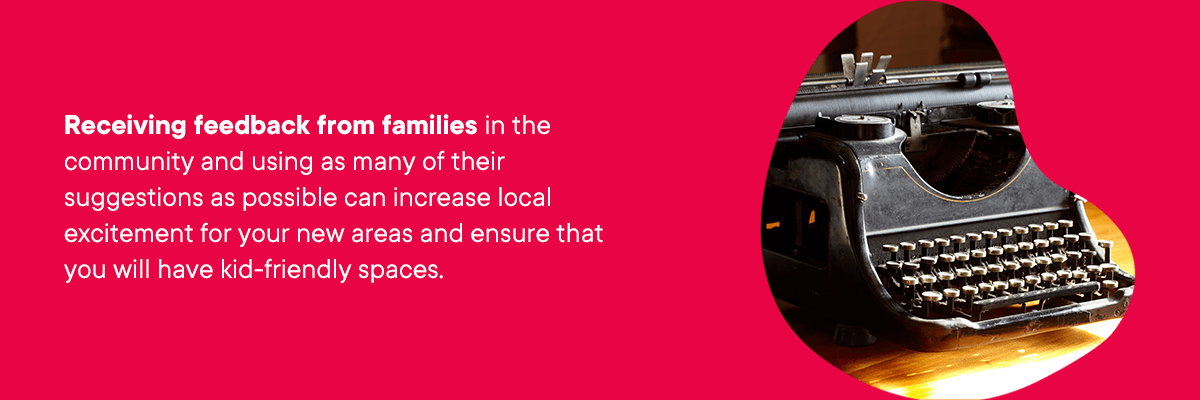
If you already have an established museum, a simple way to add zones is with rolling carts with interactive pieces that volunteers show to kids and their families. These carts turn any exhibit hall or gallery into a space with interactivity for kids. Plus, the volunteer at the cart can describe the exhibits in ways that make them more interesting for kids while answering questions.
Zones should not separate kids completely from your museum. Instead, they should be spaces within your exhibit halls where kids can engage in more kid-friendly activities or presentations. Caregivers can remain in the exhibit halls while letting their kids learn at their own pace in the kids’ zones within those same halls.
Add Hands-On Activities and Exhibits
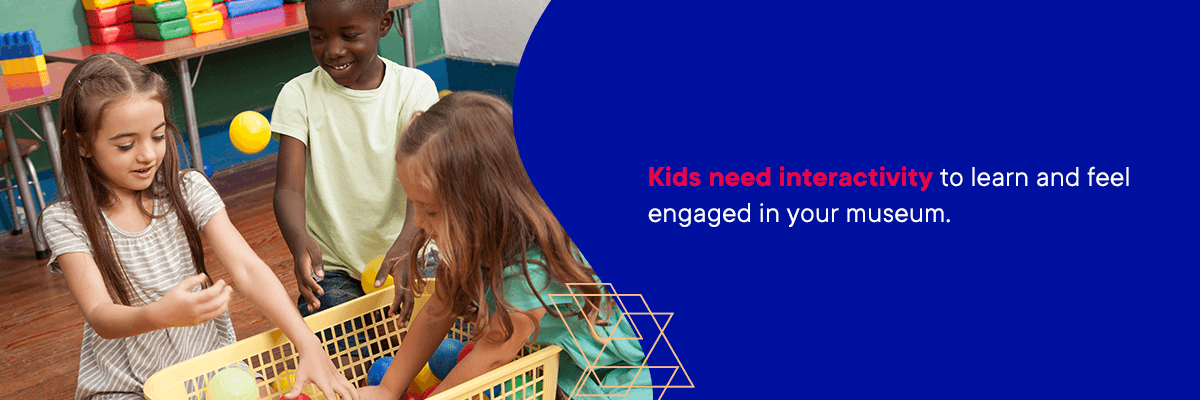
Kids need interactivity to learn and feel engaged in your museum. Hands-on exhibits can include options that allow kids to dig for replica dinosaur bones in a sandbox outside. Alternatively, kids may have the chance to create their own artwork based on the art gallery exhibits they saw.
Always have supervision in all hands-on activity areas. Depending on your museum, you may have volunteers or staff leading groups in the activities. For instance, if you have crafts for visitors to make, volunteers can guide visitors in the steps to complete the process while keeping the area clean.
Kids who have fun at your museum will want to spend more time with the exhibits, but to keep them learning, you also need to bring their caregivers into the experience with hands-on activities for the entire family. Adults and kids have more fun and learn more at your museum if you have hands-on exhibits for everyone.
The best hands-on activities allow kids to engage in fun with each other and the adults who accompany them to the museum. Creating fun spaces for learning in your museum encourages caregivers to play with their kids and for both adults and kids to get more enjoyment out of their museum visit.
Additionally, hands-on activities and exhibits appeal not only to kids but to all kinesthetic learners, who excel at learning by doing. You engage more learners of all ages in your museum’s information with hands-on activities.
Include Interactive Games
Another way to add more fun to your museum without making major changes is by integrating interactive games into the experience. For example, provide families with scavenger hunts through your museum’s app or with printed worksheets. These hunts get kids and adults excited about the museum and encourage them to explore the halls in more depth than they would have without the game.
To keep the games more interesting, offer a variety of difficulty levels for various ages. For example, for toddlers and their families, you may have a hunt that involves the kids counting the number of four-legged animals they see in a specific hall or identifying their favorite exhibit in each area. Older kids can have more challenging hunts that may require them to read the information with the exhibits or to look closely at the displays.
You can also implement technology into your interactive games with immersive interactive experiences. Create a custom digital interactive experience for all and encourage visitors to come back and play with a cutting-edge attraction. You can build a custom immersive experience with our experts at SoftPlay that compliments your museum’s brand and attractions.
These interactive games get even repeat visitors to look at your museum’s exhibits in a new light. Additionally, if you have games for different age groups or difficulty levels, you offer new challenges to visitors each time they come, encouraging repeat visitors.
Interactive games are another way to increase interest in your museum from school groups. Kids can work together to complete the scavenger hunts or other games. This type of activity lets kids learn cooperation and have something to pique their interest in their visit to your museum. They may even want to come back with their families after their school trip. To encourage participation, offer a small prize, such as a bookmark, for those who can show a completed scavenger hunt to your gift shop.
With interactive games, you easily upgrade the fun that kids and adults can have in your exhibit halls. You won’t have to make major changes and kids of all ages will enjoy the new way to experience your museum.
Instruct Tour Guides on How to Make Tours More Interesting
Tour guides can adapt their tours to the ages of the groups they lead. Instead of using the same script for all ages, tour leaders should share information with kids that the younger ones can easily understand and feel interested in. This type of information should include asking kids questions and responding to them to encourage input and interactivity.
For example, the tour guides at an art museum might ask kids to find the painting they think has the weirdest animal or the funniest hairstyle. With smaller groups, the tour guide might have the time to ask kids to make up a story for one or several paintings in the museum. This discussion provides a great chance for the guide to introduce kids to the concept of storytelling with art and inspire kids to tell stories by creating art at home.
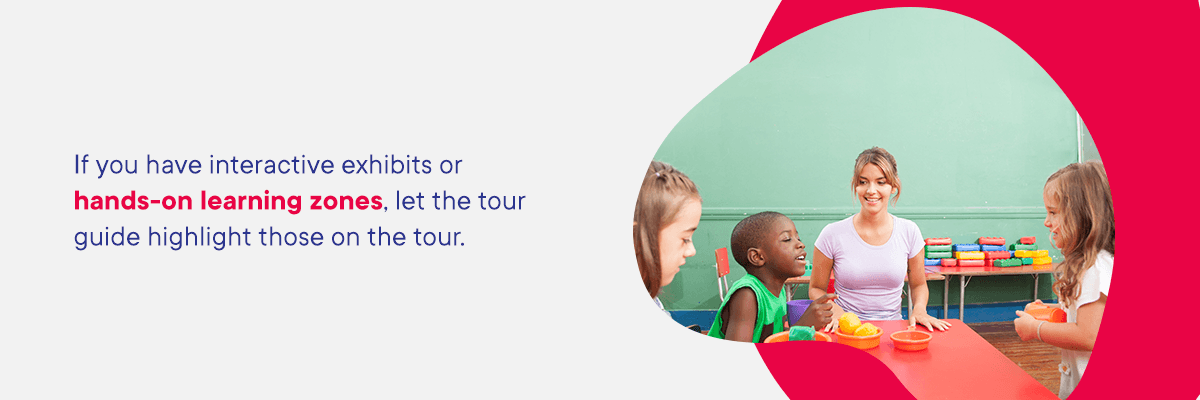
If you have interactive exhibits or hands-on learning zones, let the tour guide highlight those on the tour. The guides should also provide supervision as kids use the interactive exhibits to ensure that the visitors get the most from the hands-on activities.
Think of your tour guides as ambassadors of your museum. They provide a means of communicating the information in your exhibit halls to visitors in ways that will interest and educate them. Training your guides in offering kid-friendly tours improves the impressions kids and their families have of your museum.
Lower the Height of Your Displays
Kids cannot enjoy your museum displays if they cannot see them. Lowering the heights of your displays helps kids, shorter adults and those who use wheelchairs or scooters to better see the exhibits. For display cases that you cannot easily lower, offer footstools to allow children to see into the case. Angled mirrors inside a case can also help those who cannot see over a taller cabinet to see the artifacts inside.
Lowering the heights of displays should not be the only way that you make your museum kid friendly. It is a step in the right direction to increasing accessibility to your exhibits.
Host Kids’ Events
Host kid-friendly events in your museum to show that kids are welcome and celebrated guests. Adding kids’ events to your programs will increase family participation in your museum’s offerings. These events will vary depending on your venue’s focus.
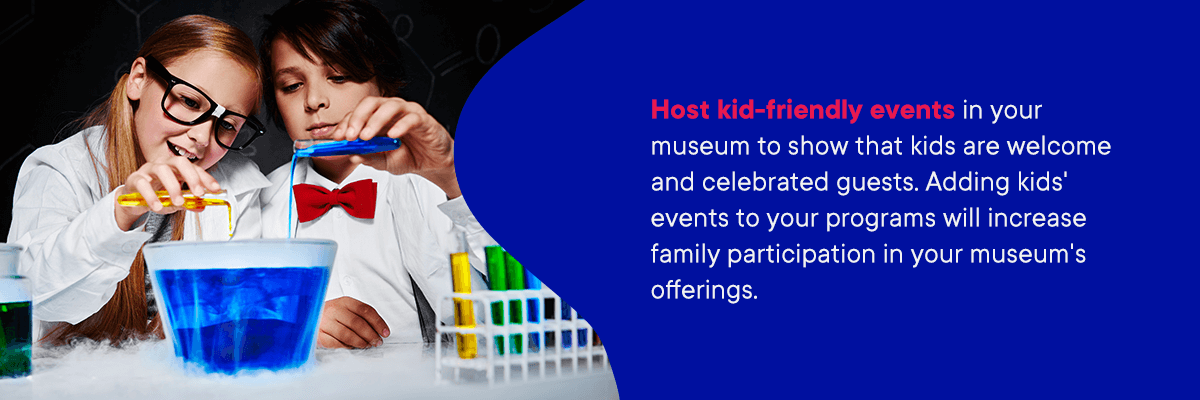
- Historical dinner parties: Hosting a period meal with foods that kids from the time would eat teaches kids about daily life during a particular time. This type of event shows kids how their peers from eras in the past lived, which connects them to history through the topic. Plus, when kids dine on historic dishes while they learn, they interact with history on their plates, adding to the excitement of the event.
- Science talks: If you have a science museum, you may have a day where kids can talk to a paleontologist about dinosaurs. The guest scientist might bring tools they use in the field or fossils to show off. Many kids have a deep interest in dinosaurs, and the chance to talk to a dinosaur scientist will likely be a sell-out event.
- Art classes: For an art museum, consider classes that unlock kids’ creativity while teaching them about art history and techniques. Provide kid-centric art classes to teach younger visitors about various art styles and have them try their hands at painting or sculpting during the class.
- Birthday parties: Kids’ events can even include birthday parties with partygoers participating in a fun class and museum tour before the birthday kid opens their presents and cuts the cake.
Offer Kid-Friendly Food
Adults won’t be the only ones who get hungry at your facility. Make sure that you serve family-friendly fare at your museum’s café or restaurant. Having child-sized portions and kid-preferred dishes will ensure that families stay longer at your museum instead of going home when the kids get hungry.
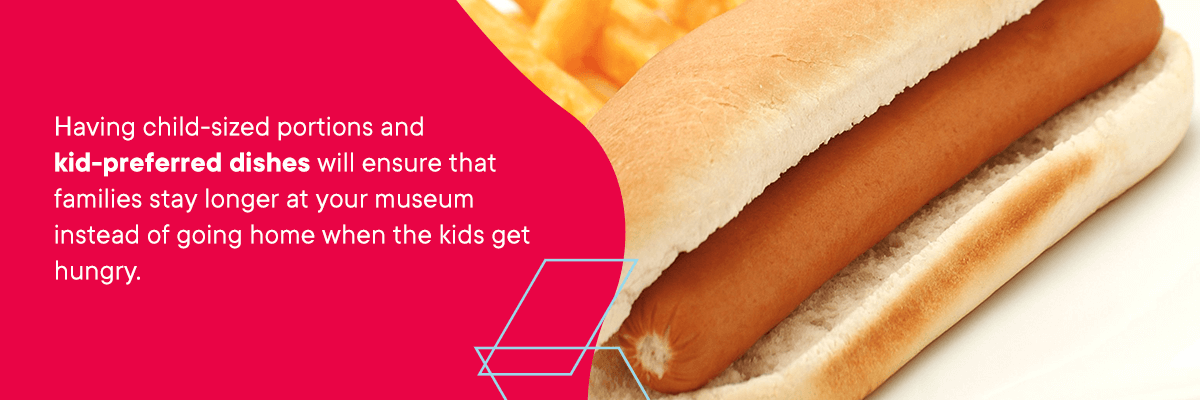
Separate kids’ menus help your youngest museum visitors to feel valued when they visit. On the kids’ menu, include foods to appeal to smaller appetites and pickier palates. These foods can include the same types of foods on the main menu but in smaller portions or with less spicy sauces. For example, if you serve pasta with a spicy tomato sauce on the regular menu, the kids’ version may have plain tomato sauce or simply buttered noodles. Make sure to have fruit or vegetables as side options so adults can make sure their younger ones still eat healthfully at your museum.
A la carte services with grab-and-go snacks and light meals make providing kid-friendly foods easy. You may already have great options for kids if you have milk, carrot sticks, apple slices, sandwiches or crackers.
The café area serves as a place for adults and kids to rest and recharge. By providing food and comfortable seating for families, you can keep them at your museum longer and ensure that everyone can continue to have a positive experience.
Stock Up on Fun Items in Your Gift Shop
You will be surprised how many kids will want to visit your gift shop if you increase the options available for them. When kids get fun souvenirs from your gift shop, they’ll fondly remember their visits.

Fun items in your gift shop should connect to your museum’s theme, colors or design to ensure remembrance of the visit. Also, include educational toys or books at the gift shop that caregivers or teachers can buy to continue the learning experience after their visit.
For example, your art museum may have art kits or books on how to draw to encourage young artists. Science museums may have science experiment kits or books on scientific topics, such as dinosaurs or the weather. History museums can have historic toys from specific time periods or books on famous people written for younger audiences.
The gift shop is often the last place that people visit at your museum. Make their final stop a fun and memorable one by offering souvenirs for all ages.
Offer Children’s Audio Guides

Audio guides provide a portable alternative to human tour guides. Many museums now bypass the need for passing out headphones by including audio guides of exhibits on their app. This method allows the user to use their own set of headphones to listen to the guide. For smaller venues, having app-based guides cuts your investment costs in purchasing, cleaning and storing headphones.
Children’s audio guides give kids a way to feel included by providing them with a guided tour of the museum that speaks to their level. Shorten and simplify the information at each exhibit to meet their understanding levels.
If you have a scavenger hunt for kids at your museum, you may include information to complete the hunt in the kids’ audio guides. Make a note on the worksheet that they will need to listen to the guide to get the needed information. If your scavenger hunt is on your app, you may include the link to the audio guide portions that pertain to an item on the hunt.
Kids audio guides are a way to give more information about your exhibits to kids, especially if you don’t have enough tour guides for every visitor to have a guided experience.
Include Actors Dressed for the Part

Bring history, science or art to life by having tour guides or volunteers dress their parts in the museum:
- Have an employee dress as a scientist and do live experiments, such as creating a balloon rocket or demonstrating the water cycle.
- A guide can dress up like a famous painter and encourage kids to ask questions about their work or other artwork of the time.
- Employees or volunteers can dress in period clothing and act as historical figures to talk about their life and impact.
With actors dressed up and playing the roles of famous people, your museum brings to life the topics that some kids may feel too distant from their lives. Plus, when the actors encourage questions and answer them seriously, kids feel heard and can have their curiosity sated.
Have Holiday and Seasonal Events
Seasonal and holiday events bring families back to your museum throughout the year. Include kids’ activities, demonstrations, actors, seasonal foods and other special programs at these events. For example, if you have a science museum, you may host winter holiday events that explore the science behind snow, actors dressed as famous scientists born in the winter, holiday foods at the café for families and programs highlighting winter holiday-connected exhibits.
Your seasonal events don’t even have to tie to holidays. You could host events for back-to-school or the start of summer vacation. Spring break is another time to host special events because kids have time off of school to come to your museum during the day with their families.
Summer camps or classes are another seasonal option you may want to add. Include one-time events where kids participate in a hands-on activity and a museum tour. When planning your museum’s special events, make sure that you have adequate staff or volunteers on hand to help visitors fully participate in the activities. For summer camps, your staff may need to have additional training to comply with certain regulations.
Multi-day camps allow kids to come to the museum for several hours to participate in various classes and museum programs. Museum summer camps often sell out quickly because they are a popular option for parents who want educational childcare during the summer.
Get creative with the types of seasonal events that your museum offers to increase excitement about your venue in visitors of all ages.
Include an Indoor Children’s Playground
Museums are ideal locations to build indoor children’s playgrounds. These sites give kids a place to play and use their extra energy. After getting their need to move satisfied on the playground, they can pay more attention to the educational aspect of your museum.
Indoor children’s playgrounds also offer adults a chance to sit down and rest while supervising their kids in the play area. Make sure to have plenty of comfortable seating for adults to encourage the supervision of kids on the playground.
You can customize an indoor playground to match your museum’s theme. Imagine including a dinosaur-themed playground in a science museum or a brightly colored one with an art theme for your art museum. Indoor playgrounds only require as much space as you want — you can use a small corner or an entire room. With a play area in your museum, you make your museum more kid and family-friendly.
An indoor playground will provide your museum with many benefits, including a way to attract and keep families in your museum, a greater return on investment in your venue and a way to promote active play in addition to your educational programs.
Contact Soft Play® Today to Create an Indoor Playground for Your Museum
If adding an indoor playground is one method you want to use to improve the kid-friendliness of your museum, connect with Soft Play for assistance. Our turnkey solutions include design support, professional installation, and customer service. If you know the type of playground you want for your museum, request a quote and our team will help you customize your options to match the theme, colors and style of your facility. Get started creating fun museums for kids today!
